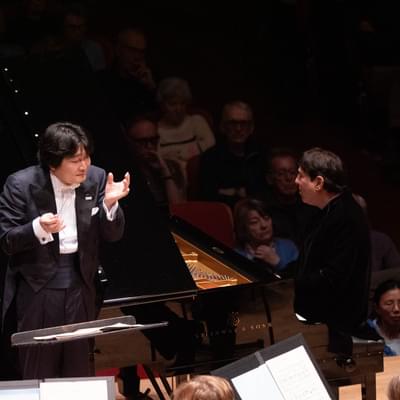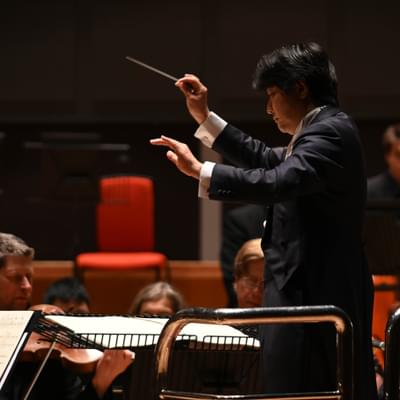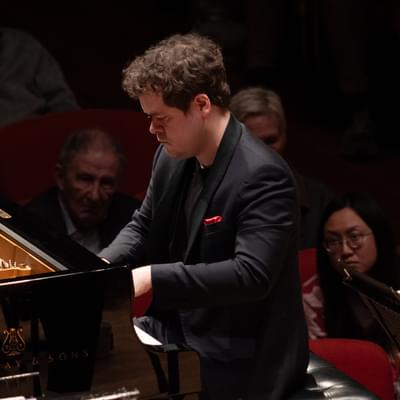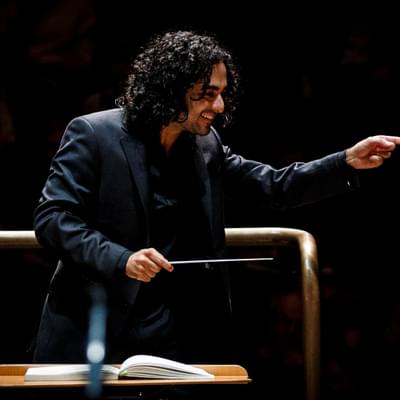Grieg's Piano Concerto
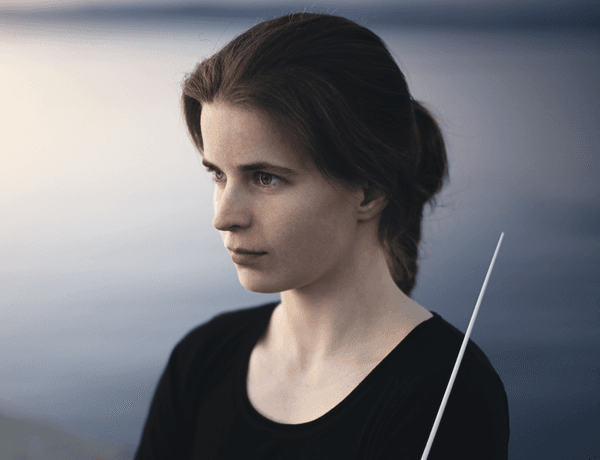
Full programme
- Sibelius, Pohjola’s Daughter (12mins)
- Grieg, Piano Concerto (30mins)
- Tchaikovsky, Symphony No.5 (47mins)
Performers

Tabita Berglund
Conductor
Paul Lewis
Piano
Introduction
Although very different kinds of struggle, a thread of fight for freedom runs through the three works in this concert.
One should be careful drawing parallels between the life of a composer and their music, but with Tchaikovsky and his fifth symphony it is hard not to. The doubts and struggles that so often tormented the man are just too present in the music, as are the soaring highs and the longing for a life that could have been. Sometimes you can almost hear him dreaming just as reality is crashing down, at others he manages to flee from his inner demons into a beautiful fantasy world, at least for a little while.
Sibelius also had his demons, but at the time he wrote Pohjola’s Daughter, the main struggle was for the freedom of his native Finland. By using stories from Kalevala for his music and giving the Finns a musical language of their own, Sibelius greatly contributed to the national identity of Finland. Finns still often identify themselves as a people of resilience, determination, grit and bravery, much like Väinämoinen in the Kalevala rune that inspired Pohjola’s daughter.
Grieg had a love-hate relationship with Norway. On the one hand, he did not appreciate the rough climate, his meagre working conditions or the state of the musical scene in Norway at the time – he did much of his composing abroad and dreamed of Italy while the rain poured down on his home. On the other hand, he loved the nature and folk music that inspired so many of his compositions, and just like Sibelius he was instrumental in shaping the national identity of his people, without which the subsequent national independence would have been unlikely.
To this day, independence remains the most important value for Norwegians to transfer to their children, and if you listen carefully, you can hear a freedom fanfare towards the end of the piano concerto.
Tabita Berglund
Conductor
Programme Notes
Pohjola’s daughter sits on a rainbow, weaving visions and spells, but tonight it’s the young Norwegian conductor Tabita Berglund who’s bringing magic from the North. That means raw emotion, in the symphony that Tchaikovsky composed “with desire and passion”, plus sounds that glow like Aurora Borealis as British pianist Paul Lewis plays in Grieg’s enchanting Piano Concerto.
Pohjola's Daughter
Jean Sibelius (1865-1957)
The inspiration for Sibelius’ 1906 tone poem is the ‘Kalevala’ saga, a Finnish epic which Sibelius would draw on a number of times. While the title is Pohjola’s Daughter, Sibelius focuses largely on the Kalevala’s central character of Väinämöinen: the bearded, ancient wise man with magical powers (he is known to be a model for JRR Tolkien’s Gandalf) and particular associations with music. Sibelius takes an episode of the Kalevala in which Väinämöinen approaches the beautiful ‘daughter of the north’, inviting her to travel with him (‘Pohjola’ is not a person, but rather means, broadly, the Northern lands). A self-sufficient mythical maiden, happily weaving a cloth of gold while perched on top of a rainbow, she is clearly not interested in this elderly suitor. She agrees to accompany him only if he fulfils a number of challenging tasks, including tying a knot in an egg (which to be fair would defeat most of us) and constructing a boat from the broken shards of her weaving distaff. Väinämöinen is partially successful through using his magic powers, but is ultimately distracted and wounds himself with an axe. He continues his journey alone.
After writing two symphonies, Sibelius clearly enjoyed the freedom of the tone poem, compared with what he felt to be the formal restrictions of the symphony, writing: ‘This is my genre! Here I can move without feeling the weight of tradition’. While containing some ‘classical’ elements (such as themes, developments and recapitulations), Pohjola’s Daughter has a much looser structure, allowing a colourful narrative to emerge. It opens with epic grandeur – suggestive of the world waking up – and ends by depicting the splintered fragments of Väinämöinen’s ego as he retreats alone. In between is a depiction of the daughter’s beguiling appearance in the harp and sweetly trilling woodwind, Väinämöinen’s first attempt at the tasks (in pizzicato strings) followed by the daughter’s sarcastic laughter. She laughs even louder a few minutes later, in raucous upward figures in the brass. Part epic myth, part tips on how to repel unwanted suitors, Pohjola’s Daughter is a sparkling triumph.
Piano Concerto in A Minor
Edvard Grieg (1843-1907)
I Allegro molto moderato
II Adagio
III Allegro moderato molto e marcato
When André Previn died in 2019 tributes in the press came thick and fast, generously paying homage to a great and multi-faceted musician. In the United Kingdom, nearly all of the headlines concerned his famous appearance in the 1971 Morecambe and Wise Christmas special, conducting Grieg’s Piano Concerto. As such, this work has a special place in the heart of British listeners of a certain age, and (especially the opening bars) can be tainted with over-familiarity. But this work still has the capacity to surprise, as might the following two facts: it is the only concerto Grieg composed, and he was a mere 24 years old when he wrote it.
Grieg was a virtuoso concert pianist and while he did not give the premiere of the work himself in 1869 he performed the solo part on other occasions, especially when touring in Europe. It reflects his great admiration for Robert Schumann’s only piano concerto: also in A minor, also opening with a flourish. Yet it is a personal work, shot through with Norwegian folk melodies, and containing a musical ‘fingerprint’ which would appear in many of his subsequent pieces: the opening three notes (A,G#,E) comprising a falling minor second and a falling major third.
Following the opening timpani roll and mini-cadenza on the piano, soloist and orchestra romp through a breathtaking series of themes, numbering four showstoppers by the third minute, the last of which is sumptuously romantic. As if in celebration, the piano plays another mini cadenza, followed by an orchestral version of the opening theme in a boisterous major key. And so it continues: variations on the opening themes, alternating and cleverly weaving in and out of each other, plus some touching solo spots for several instruments. The piano lets rip in a more sustained cadenza towards the close of the movement, followed by an orchestral rounding-up of various themes in the final bars.
The Adagio movement has a lyrical grace, and a yearning, nostalgic quality to its principal theme. A decorative piano melody in the middle section leads to some agitation of its calm surface, but overall the mood is serene throughout. The final movement pays tribute to the Norwegian ‘Halling’ folk dance in the rollicking opening bars, then harks back to the Adagio with a swooningly gorgeous second theme, initially introduced by the flute. In a dramatic piano version of this theme in the closing seconds, Grieg flattens the second: not perhaps the most thrilling gesture on paper, but observe the effect it had on Franz Liszt on hearing it the first time. Liszt marched about the room bellowing the theme, flinging his arms out and declaring ‘G, G, not G sharp! Splendid! That’s the real thing!.’
Symphony No.5
Pyotr Tchaikovsky (1840-1893)
I Andante – Allegro con anima
II Andante cantabile, con alcuna licenza
III Valse. Allegro moderato
IV Finale: Andante maestoso – Allegro vivace
Tchaikovsky was a prolific composer, possessed of a mercurial, turbulent character and often a powerful sense of self-doubt. His life was punctuated by dramatic relationships (such as his short-lived marriage) and fallings-out with friends. But in the summer of 1888 he was in tentatively good spirits, embarking on his fifth symphony while on holiday in Frolovskoe, not far from Moscow. Despite having worried to his brother Modest that his talent was drying up, he wrote shortly afterwards to patron Nadezhda von Meck ‘I cannot tell you what a pleasure it has been to watch my flowers grow and see daily – even hourly – new blossoms coming out….I have been working with good results, for half the symphony is now orchestrated.’
The symphony continued to bloom and grow, forming its structure and atmosphere around a dominant motif first heard at the start, then periodically across the whole work. Tchaikovsky noted that the symphony’s ‘programme’ suggested ‘Complete resignation before Fate, or…the inscrutable predestination of Providence,’ and the opening theme is frequently described as the ‘fate’ motif. The symphony is abundantly rich in other melodies, with four significant themes in the first movement alone, ranging from jaunty to yearning. Yet most of them bear at least some resemblance to the fate motif, either through a dotted, stuttering rhythm or a downward slope of melody. The opening movement ends not with a bang, but with an ominous, whispered descent into the depths of the orchestra.
The second movement begins with one of the most famous themes in the orchestral repertoire, initially on the solo horn (any resemblance to the famous ‘Annie’s Song,’ is – according to John Denver – entirely accidental). A clarinet joins in with a soulful counter-melody, followed by an oboe determined to cheer things up with a new melody. These themes, along with a pulsing underpinning from the rest of the orchestra, lead Tchaikovsky towards the romantic territory of his ballet Romeo and Juliet, composed some eight years earlier. The ‘fate’ motif dramatically intrudes into atmosphere twice during the movement, the first time seeming to send the orchestra into shock before it regathers with the opening theme. The delicate, dance-like third movement borrows its melody from an Italian street-song, and the ‘fate’ motif takes more or less a back seat. Yet it is strongly to the fore in the finale, where it eventually transforms into a major key. For some, with its repeated blasts from the trumpets, this is a ‘triumph’ over fate. Yet Tchaikovsky was not especially happy with the conclusion, writing that it had ‘a certain excess of gaudiness and insincerity.’ Yet, perhaps with ears attuned to ironic overstatement (such as at the end of Shostakovich’s Fifth Symphony some years later), we might feel those final E major chords have a darkly sinister edge.
© Lucy Walker
